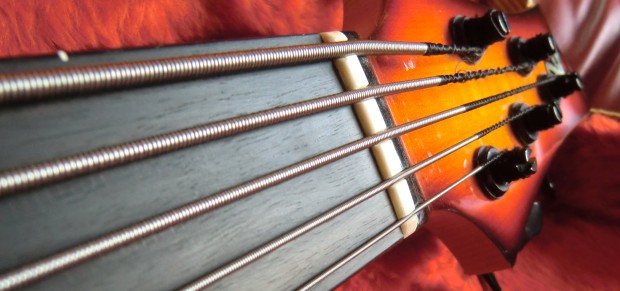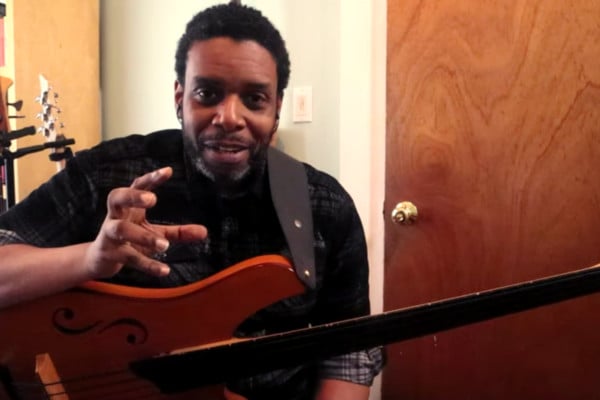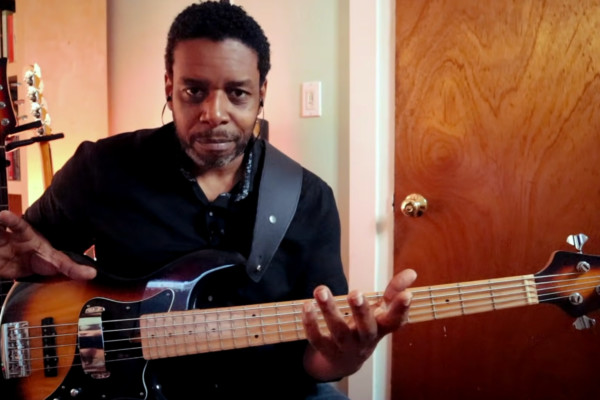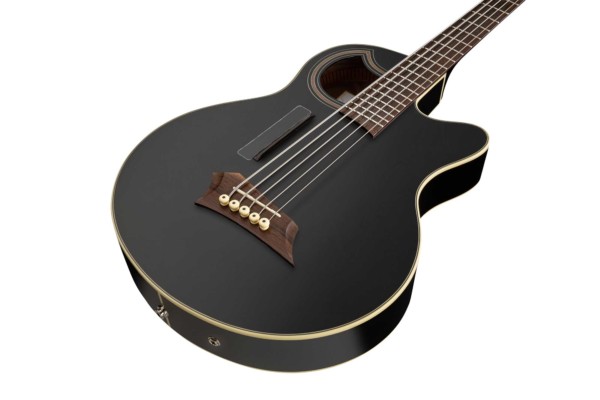Getting Better Intonation on a Fretless Bass

Q: I’ve recently made a switch from fretted to fretless bass, and so far it’s been awesome, but here’s the thing… A couple of the fretted basses I’ve played so far were all 34-inch scale, and the fretless I now play is a 35-inch scale six-string – and it’s unlined. So stretching my fingers that wide is becoming a pain in the… fingers. It seems to greatly affect my intonation on the bass. I would be really grateful for any advice on “the fretless switch” in respect to scales. I know in time and with a lot of practicing things will set in, but are there any shortcuts or just helpful tips to speed things up a little, since this my only bass right now and I have a couple of gigs coming up soon.. All the best and utmost respect from Bosnia!
A: Unfortunately, there are no real short-cuts to muscle memory. The more you practice, the more quickly you will acclimate to the instrument. That said, what you practice will also have an impact on the expediency of your shed time.
- Practice slowly through a chromatic tuner. Focus on one position at a time and play a collection of scales (including the chromatic scale) through the tuner, also paying close attention to your hand position.
- Practice Bach cello suites or some other scalar study type of classical piece.
- Practice diatonic arpeggios. Do this both in one position but also traveling horizontally along the neck.
- Practice slowly! If you have iReal Pro, even just playing whole-note, roots through changes at a slow tempo can really help to tune your ears and hands to the intonation. If you play too fast, your brain doesn’t register the out of tune notes as well. Things can sound “close enough” to in tune, if one plays fast enough. Practice slowly and get a feel for holding a note. Notice how the note changes ever so slightly when you twist your hand one way or the other.
- Don’t get too obsessed with intonation when actually on the gig. Save it for the shed. Just work on it and continue to improv it over time. If you focus on it too obsessively at first, it can really hinder your ability to make music. Make allowances for slight adjustments and slurs and try and make them musical. I’ve had some students that have gotten temporarily paralyzed by obsessing over the accuracy of each note (ie: only hearing how this or that note was flat and not focusing on the music they are making). Try thinking of the notes as words and consider any nuances to be more of a vocal inflection. I’ve found that this slight shift in perspective can help one to play more musically, even if the intonation isn’t perfect (of course, you can’t just go sliding up and down the neck, searching for notes, but I think most of us can find a balance.
There are also a few things you might try in an effort to do as well as possible on your gigs while you are internalizing the instrument:
- Add fret dots or lines of your own. You can actually buy stick-on dots for the neck of your bass and, if you put them on the side of the fretboard, nobody will even know except you. I’ve also found it helpful to use a pencil and lightly draw some lines on the side of the neck (I did this on my electric upright). Be aware that those lines very well may disappear on stage, depending on the lighting! Personally, I try to use the guides when making a large leap or when I hear myself drifting out of tune. More often than not, I try to use hand positions and muscle memory. I want to constantly tune my ear to the sound of each placement of my fretting hand (get a ‘feel’ for what movements in each position sound like).
- Memorize the music. This may or may not apply, but I’m reading notation on 90% of my gigs and I know from past experience that my intonation takes a dive when my face is glued to the page (remember, that I don’t often play fretless). My intonation is pretty good when I can really just focus on the instrument. Allowing all of your attention to get laser focused on intonation and hand position will go along way in compensating for a current lack of muscle memory.
I’d really like to hear from readers on this one, as I generally only play fretless when called upon in the studio or on certain songs, on certain gigs and never as a full-time instrument. Have any of you found a “fast-track” to intonation beyond time and attention? If so, please share in the comments.
Have a question for Damian Erskine? Send it to [email protected]. Check out Damian’s instructional books, Right Hand Drive and The Improviser’s Path.




I mainly play fretted bass, but I have a fretless that I tend to practice on purely to work on my muscle memory and ear/intonation training. Depending on how good your ear is, vibrato is your friend when it comes to playing fretless. Tou can also slide into your notes a little too. I Finally, make sure your bridge is set up correctly, it makes a world of difference!
all good points, but practicing through a chromatic tuner will slow down the process … really. Practice with a backing track of a chord, or a shruti tone, ALWAYS judge by ear, never by eye. Music is a hearing art. I Practiced wit a tuner for a couple days, it really drove me completely nuts. I started to use a shruti and/or backing tracks, and my intonation improved by the minute… you should really learn to hear it asap.
That sounds like great advice! I was thinking of upright guys and bows when I wrote that part, I think but what you wrote is more relevant. I love playing along with drones. nailed it! ;)
I’ve recently ‘re-bought’ an unlined fretless (as I had one years ago, but due to inexperience it just didn’t work for me), and I really love the extra pallet of sounds it gives me. I’ll never be a virtuoso on it, but a couple of techniques really work for me. 1) Work out all you bass lines on a fretted instrument first (if you have one). Only when I’m totally at ease with the material do I then transfer to the fretless. This way I know how the bassline sounds, and am able to pick out the ‘ouch’ moments pretty quickly. 2) Whilst people like Mick Karn, Pino etc are really good at showing how recognisable fretless techniques can be, I think it’s also important to check out those fretless players who play for the song, not to demonstrate the fretless instrument. Jeff Ament, Sting’s Police years, and Boz Burell (King Crimson/Bad Company) all played fretless, but are known for being bass players, not ‘fretless bass players’. It helps put the instrument in context and shows that it can be less flashy, and just as supportive as it’s fretted counterpart. They demonstrate that a fretless can be played (more or less) like a fretted, and it’s the tone and feel that sets it apart, not just slides, vibrato etc.
I just made the switch and the two things I’m working on are the Bach cello suites and IReal Pro. So apparently I’ve been doing it right.
Two other things that help: play songs you already know (so you’ll be able to tell when you’re out of tune) and play against an open string to give yourself a reference point.
I play mostly on my fretless these days. Last year I had a new 4 string build by Danish luthier Johnny Mørch. It has nice maple lines laid in the ebony fretboard because I don’t care if people (other musicians :-) can se the lines or dots. I play to make music and the love of the game, so for me personally I can’t see the idea in trying to hide them, a bit like a blind man trying to hide the guide dog :-) I practice a lot by playing the melody line in Danish/Scandinavian traditional folk songs, and also hymns/psalms and other stuff with strong melodic lines that I know by heart. Also I’m improvisinging over the same songs. When I play things like that, where I’m confident with the melody and the structure I can focus on the intonation and how to shape the notes in different ways. I love playing the fretless, I feel so free when I play with no boundaries other than my thin white maple lines.
As a strictly string bass/fretless electric player here, I’m going to go out on a limb and suggest that to play in tune, you have to know when you’re out of tune. Practice helps certainly but you always, always, always must listen. If you don’t have frets, the only safety net you have are your ears, and they’re useless if you don’t know what the music is supposed to sound like.
Regarding the stretch issue, you could try using 1-2-4 fingering in the lower positions (also known as Simandl fingering if you learnt double bass). The idea is that fingers 3 and 4 work as one, so in first position you would play:
1st fret – 1st finger
2nd fret – 2nd finger
3rd fret – 4th finger (with 3rd supporting)
Lots of double bass players use this to manage scale lengths of up to 43″, so it’s quite comfortable at 35″. The payoff is that one position only covers 3 frets, so it can need more shifting.
I’ve found that a good way to judge your intonation against another instrument is to listen out for beat frequencies (a beat frequency is the ‘wobble’ that happens between two notes that are slightly out of tune. The frequency of the wobble is the difference between the frequencies e.g. If you play an in tune open A at 55Hz against a slightly flat A at 54Hz, you’ll hear a 1Hz ‘wobble’ in the sound). With practice you’ll be able to hear them in octaves, fifths, fourths and whole chords. It can be really useful when the guitarist pulls out the slide or a piano is out of tune!
About feeling over-stretched on the 35″ scale… since you don’t have lines, you could move the bridge up 1 inch to achieve your familiar 34″ scale (would have to use the adhesive side dots in the proper locations, of course).
I am sorry but moving the bridge does not change the scale of the finger board.
I’ve been playing fretles for a number of years and try to rely on muscle memory. But when I have to sight read a gig with fretless, I cut small (1/4″) squares of bright pink or bright yellow gaffer’s tape (yes, they really make this; available at most stage and theater supply companies) and place them over the side dot markers. Discrete, bright under almost any intensity of stage or pit lighting, easily removable, and the adhesive of gaffer’s tape does not harm guitar finishes in short term use.
At first I was writing the lines I have to play in a music software and I played along with it.
This worked but it was a bit tedious.
After this I discovered the “Sonuus B2M” (analog to MIDI converter) and his chromatic mode. After asking some questions on their forum to be sure that my idea could work I buy one and I am realy happy with it.
In chromatic mode the Sonuus B2M send the right pitch to the MIDI sound module.
If you play a bit too high or too low, the MIDI sound clash against your bass sound and you can correct it in real time, it’s really helpful when practicing scales or reading.
And I also marked the neck as you can see in this video.
(sorry, the text is in french on my website)
http://www.videoinmotion.be/portfolio/marquage-touche-fretless/
Play open strings and /or harmonics (when appropriate) for an in tune pitch reference ….
From my experience, a change of perspective can really help. In order to improve my intonation I chose some of my favorite singers and tried to imitate their voices with the fretless bass. This got me into the understanding of the nuances you can play with the instrument. Stop worrying too much about intonation and work more on expression, as a result intonation comes into place.
Since there’s no shortcut to muscle memory, in think one must learn to properly play on fretless bass whithout getting tempted to rely on too much vibrato to mask slightly out-of-tune notes. Vibrato on a fretless is great when used to get the vibrato feel/effect, as an additionnal touch, not as a requirement.
In order to lean my fretless fingerboard, I second the idea of memoryzing the music to focus on the notes and not on the remembering of the song itself. So when I practice fretless at home, I tend to play song from my band’s repertoire, which I play on a fretted bass with a pick. This way I completely focus on the learning to play with my fingers on a fretless and don’t have to actually think about the song itself.
Great advice, Damian! Love the ideas about playing slowly and about listening and focusing on whole notes rather than trying to race through. I also second Luc’s idea of playing with a drone, which I have found extremely helpful for both upright and fretless.
Most things have been said already, but I think I would want to add this: 1) play/practice double stops (3rds, 4ths, 5ths, 8ves); 2) practice the same phrase in different positions; 3) choose strings with a less bright sound (very thin, bright strings make imprecisions more evident); 4) on a double bass, different strings have different stability in term of pitch (once plucked, the note starts flat and raises to its actual pitch) – maybe it’s an issue on longer scale bass guitars too; 5) no matter what, you’ll have to deal with intonation all your fretless life – it may ne good to be mentally prepared for that.
Cheers
mtt
for me it worked playing fretless on drones with a click (to practice intonation and timing at the same time). it helps heaps playing slow, playing tunes that I am already familiar with on a fretted, and playing along backtracking.
I have tried playing fretless while looking at a chromatic tuner, but that didn’t work for me at all. No evident progress, if anything I was getting way too paranoid and not having fun.
Sometimes I use the fretless when I’m learning a mode, or a scale that I never practised before. I feel like the fretless really opens my ears and I don’t feel stuck to a visual pattern or grid, as that sometimes happens to me on a fretted..
I definitely prefer the fretless without lines on the fretboard.
I like to remind myself that our fellow classical musicians do amazing things on their violins, viola, cello and upright, and they never look at the fretboard, even not once.
I can give a few advices :
You can make a little slide to reach the note you want, so you can hear when you reach the right note.
You can watch video on YouTube playing cello violin or upright bass to look how attacking the note with your left hand (for exemple vibrato effect)
You can play over playback video on youtube.
Trying to play with your ears and soul and not focus to much on the fingerboard
keep ears open, and a octave exercise if the octave sounds good its fine, also play in a dark room to keep eyes out of the freet board
Some great advice here, including the comments.
Couldn’t agree more about learning to ‘hear’.
Practicing in a completely dark room can work well.
Also, try recording yourself and listen back to it.
You’ll realise how bad you are and you’ll practice more!
I used the completely insane total immersion method. When I heard Jaco on Heavy Weather, I decided to go fretless…with my only electric bass, a ’69 Jazz Bass. I took it to the shop, and had them remove the frets and replace them with maple strips for lines. On the day I picked the bass up, it turned out that I had a concert at MIT. Let’s just say that hilarity ensued.
After that I knew I really had my work cut out for me; I just practiced a LOT, figuring that it would require a certain minimum amount of time to train my muscles and ears to the point where I would feel comfortable again. The approach worked; I was able to re-emerge into full time work in a few weeks, not at 100% virtuosity but good enough. Of course, I continued to work on the fretless after that until I felt really comfortable.
While the wisdom of that approach may have been questionable, it certainly provided a good deal of motivation :-)
Unlike the upright, electric bass has few physical landmarks, and I found the lines handy for reference. Eventually I ended up using them more for situations where I would have to start a passage decisively on the right pitch at the beginning of a piece, or after a significant rest. They’re not a requirement, after all double basses, cellos, violas and violins have none, and we don’t ever look at the fingerboards when we play them.
I always found the lines distracting to my eyes and way more confusing. So I prefer unlined basses. A few simple dots for quick reference is simple and easy to comprehend on the fly. Hearing my fretless bass is the most important thing. I found adding mids to the sound when in a live gig situation helped cut through the band so intonation can be acheved. Getting that smooth warm tone that I love when practicing never sounds as good at the gig. I have to grin and bare the unfamiliar sound at first but my ears adjust after a few songs and by the second set all is well.
I agree with what’s been written before in the comments.and i may add that using a chorus or vibrato pedal with a moderate settings can help too.
I heartily endorse the points: 2,3,4,5. & 1,2
I would also add: Go to your bass in a darkened room – I learned a good deal about my upright/fretless in the dark! pierre
Suggestion that works for me on the URB:
When practicing an interval through a chromatic tuner, make certain the starting note is correct. Then play the next note, if your ear says “OK” THEN look at the tuner. If it is wrong, play the interval again. Repeat until you can make it _correct_ many times. Then go to the next interval. …
And do all this slowly. This is not a “real time” exercise. You are training your fingers to go to the right spot _every_ time. You can speed it up later.
Keep a consistent posture and hand position. Playing octaves, fifths, and fourth will be easier to judge than smaller intervals. Double stops of octaves, 5ths, and 4ths, will help hearing and hand position. Playing against a drone (get a sound as close as possible to Sine wave) will help hearing. Playing the melody of simple songs is great, since you already know what the sound like.
The task is to learn to hear what ‘in tune’ sounds like. This is why playing with backing tracks or drone sounds are the best help.
Alway check tuning before a practice session. Best to stay with one bass until you become secure in playing. (keep everything as consistent as possible).
Remember, working on intonation is a part of playing a fretless instrument. You will always be working on that. Achieving good (passable) intonation is a process, not an event. Make it apart of your life.